Which Attic Insulation Should I Pick?
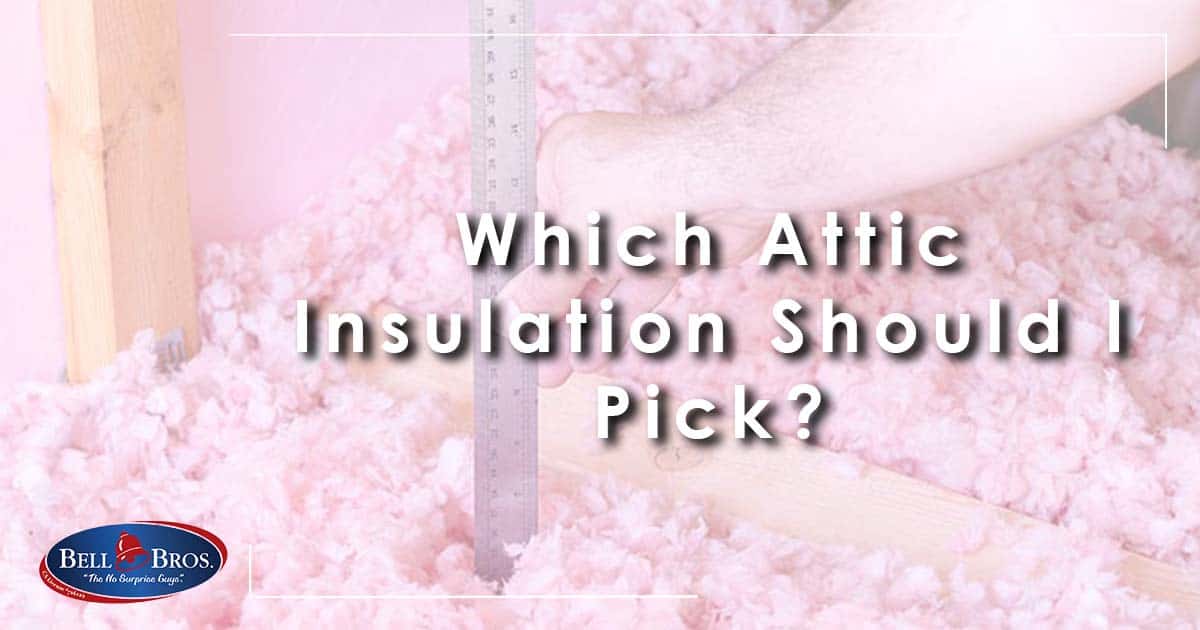
It’s obvious that attic insulation isn’t a luxury. It’s a necessity among homeowners. In order to keep their homes warm, their heating effective, and their heating bills low, it’s fundamental to have good attic insulation. After all, if you’re powering up the heating to maximum every hour of every day because the heat doesn’t stay trapped inside your home, you’ll know about it from your energy bills.
But how do you pick the right attic insulation type for you? What are the benefits of different types of attic insulation, and, equally, what are the drawbacks?
This article will shine a light on all 4 types of attic insulation, what they can offer you, and things that you’ll need to know before you make your decision.
Fiberglass Batt Insulation
Fiberglass batt insulation is the firm favorite amongst homeowners, being the most commonly installed type of attic insulation out there. When you think about attic insulation, you often picture fluffy rolls of material. That’s fiberglass batt insulation.
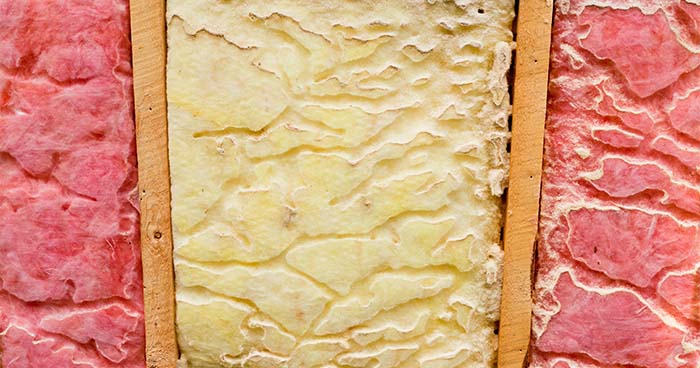
The fiberglass is made from little glass fibers. Before becoming glass, it was originally recycled material and sand.
These glass fibers are then used to form batts. Batts are large, rolled up sheets of material, stuck together with vapor. The vapor acts as a barrier by gluing it together.
The Advantages of Fiberglass Batt Insulation
Why is fiberglass batt insulation the predominant choice for many homeowners? What does fiberglass batt insulation offer you?
- Generally speaking, fiberglass is pretty eco-friendly. The fiberglass is formed from sand, which is then turned into glass, making it a renewable source of energy.
- The vapor barrier treats the insulation to make it flame-proof, allowing you to rest easy knowing it can slow the spread of fires.
- Fiberglass batt insulation doesn’t shrink or collapse easily, thanks to the air pockets that form during installation.
- Installation is simple. So simple, in fact, that many homeowners choose to install it themselves rather than hire a professional.
- This attic insulation not only protects heat but also sound, keeping noise in (which will please your neighbors) and preventing it from penetrating your home from outside.
The Disadvantages of Fiberglass Batt Insulation
Fiberglass batt insulation is a great choice of attic insulation, but it’s not without its drawbacks:
- Fiberglass is, in essence, tiny slivers of glass. Glass, in any condition, causes an injury risk.
- The vapor used can be harmful if inhaled or touched. If you choose to install it yourself, you’ll need to wear a mask and gloves for safety.
- Should the fiberglass batt insulation get wet, you’ll notice heat escaping quickly. The moisture makes it ineffective, and it takes a long time to dry out. That’s bad news if you have a leaky roof.
- Should it absorb liquid, you may see mold grow and develop, which is a safety concern.
- Rodents enjoy making nests in fiberglass batt insulation, increasing the risk of a rodent infestation.
- The required thickness on average (270mm) to have sustainable insulation value makes it tricky to install floorboards.
Blown-In Fiberglass Insulation
Another option you have for attic insulation is blown-in fiberglass insulation.
This uses the same slivers of glass and recycled material, but the way it’s distributed differs from fiberglass batt insulation.
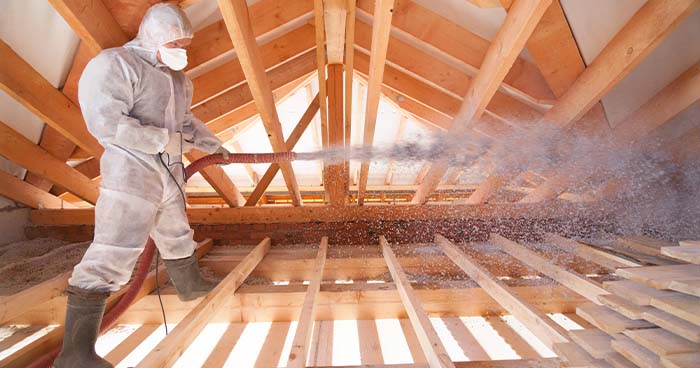
Instead of using batts of fiberglass, the material is blown in to fill the space instead. Some sources say that, by adjusting the method of application from rolls to blown-in, you can save up to 35 percent on your heating bills.
The Advantages of Blown-In Fiberglass Insulation
Is blown-in fiberglass the best attic insulation choice for you? Here’s the advantages of blown-in fiberglass insulation:
- Blown-in fiberglass is energy efficient for the planet and your bank account.
- It fits the room better, making it a more air-tight version of attic insulation.
- Due to this, it fills more gaps, cracks, and awkward spaces. This reduces the risk of cold air entering and hot air leaving your home.
- It also traps noise.
- The blown-in method makes it far quicker to get up and running. Installation usually takes a few hours, rather than a few days.
- The air quality is often improved in homes that use blown-in fiberglass insulation. This is down to the lack of chemicals or additives. Better air quality is considered a priority for homeowners who have allergies.
The Disadvantages of Blown-In Fiberglass Insulation
Looking at the benefits of blown-in fiberglass insulation, it seems a perfect method for your attic insulation. But what about the disadvantages?
- Fiberglass — whether in the form of batts or blown-in — can be a health risk. It’s often sold with a health risk warning, which should be taken seriously.
- When fiberglass insulation settles, the R-Value drops. It’ll likely need maintenance after a shorter period of time than other attic insulation types on our list.
- If the insulation gets damp and grows mold, rectifying it is painful. Due to it not being rolled up in neat rolls, you’ll need to remove it with gloves, one by one, placing it into a bag for removal.
Blown-In Cellulose
Contrasting our previous two types of attic insulation that differed due to methods of distribution, this form of attic insulation keeps the same blown-in method, but differs in material.
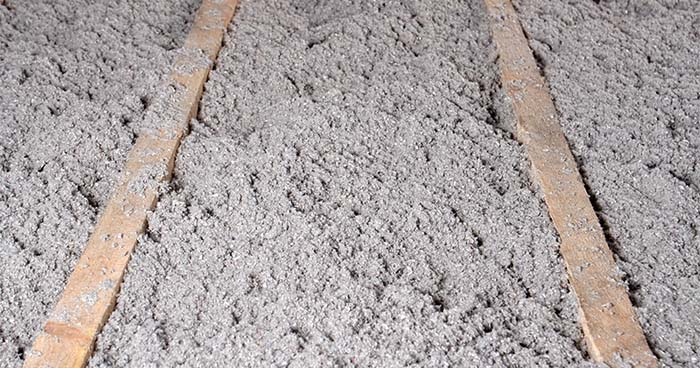
The material used here is cellulose. Cellulose comes from recycled material, such as newspaper, cardboard, and wood-based materials. It’s then combined with boric acid and other chemicals for flame-proofing.
Then, just like our blown-in fiberglass insulation, it’s blown out into the attic to fill the required space.
The Advantages of Blown-In Cellulose Insulation
Is blown-in cellulose the best type of attic insulation? Here’s what it can do for you:
- As a whole, blown-in cellulose is better for the environment. Consider that cellulose is created with recycled material, rather than producing new material.
- The boric acid and other chemicals help with flame-proofing, which reduces the chances of a fire originating from the attic. Plus, it slows flames if a fire has broken out elsewhere.
- The R-Value is better than fiberglass batts by a massive 23 percent.
- Cellulose helps with wind washing.
The Disadvantages of Blown-In Cellulose Insulation
Is blown-in cellulose the best type of attic insulation? Here are the disadvantages of blown-in cellulose:
- While cellulose itself is eco-friendly, the chemicals that are added are not. There’s only 3 mines that produce boron, which is needed to create boric acid. The mining process to obtain boron is very harmful to the planet.
- The blown-in method can be a messy one, rather than using batts that are laid out in neat rolls.
- Cellulose doesn’t mix well with moisture. If it gets too damp, it can spread mold quickly, and rectifying this situation isn’t easy.
Spray Foam Insulation
Spray foam insulation is growing in demand and popularity. This is down to its many benefits, which we outline below.
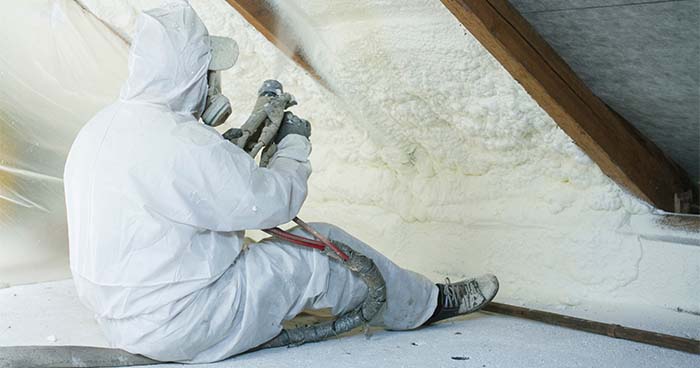
Unlike all the other types of attic insulation on our list, spray foam insulation is the only type to come in liquid form.
After being sprayed out, it grows in thickness and sets as a durable foam. The foam slides into any gaps, locking airtight, and blocks any escape routes for the heat in your home.
The Advantages of Spray Foam Insulation
With the increasing popularity of spray foam insulation, it’s clear that homeowners are reaping the benefits, like:
- While fiberglass wilts over time, spray foam insulation remains high-performing in both the short and long run.
- Spray foam insulation has an R-Value of 5.6 and 8.0, which is impressively high.
- The foam can even add structural strength and support to your property.
- Due to the high R-Value and ability to block any holes or gaps, spray foam insulation is excellently energy efficient.
- There’s no need for a vapor barrier.
The Disadvantages of Spray Foam Insulation
Our final attic insulation type on our list, spray foam insulation, does have some disadvantages:
- The initial outlay is higher than other forms of attic insulation. It’s worth considering, though. Due to its energy efficiency, it balances out in the long-run and can actually save you money.
- If any gaps are missed during the installation process, the spray foam can create water damage.
- This water damage can evolve into severe property damage if not dealt with properly, and this can be expensive.
- As such, it’s fundamental to have a professional install your spray foam attic insulation. This requires payment for an installation fee.
- The chemicals required to create the foam are dangerous if they are inhaled or come into contact with your skin. It can cause inflammation, swelling, and skin reactions. So, you’ll need to wear gloves, goggles, and a respirator every time you’re near the foam.

